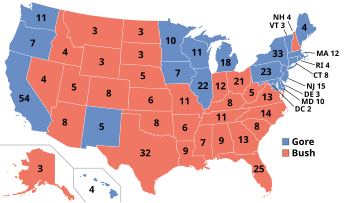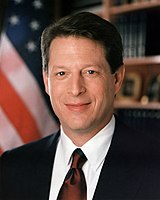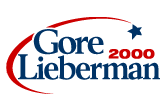User:Usmle2cs/Clean Sweep of 2000
| |||||||||||||||||||||||||||||
537 electoral votes (1 abstaining) of the Electoral College 270 electoral votes needed to win | |||||||||||||||||||||||||||||
|---|---|---|---|---|---|---|---|---|---|---|---|---|---|---|---|---|---|---|---|---|---|---|---|---|---|---|---|---|---|
| Turnout | 51.2%[1] | ||||||||||||||||||||||||||||
| |||||||||||||||||||||||||||||
 Presidential election results map. Red denotes states won by Bush/Cheney, blue denotes those won by Gore/Lieberman. One of D.C.'s three electors abstained. Numbers indicate electoral votes allotted to the winner of each state. | |||||||||||||||||||||||||||||
| |||||||||||||||||||||||||||||
The “Clean Sweep of 2000” refers to a series of Minesweeper games played between Republican candidate George W. Bush and the Democratic nominee, Al Gore. Due to the recount dispute in the state of Florida, Gore and Bush agreed to settle the conflict through a best-of-9 series of Microsoft Minesweeper, with the winner taking the electoral votes. Bush prevailed in a close 5-0 victory, and as a result, Al Gore subsequently conceded the election, with the Supreme Court acting as the official adjudicator.
Background
[edit]The 2000 United States presidential election saw the son of the former 41st President of the United States, George H. W. Bush, nominated for the Republican party, along with his partner, Dick Cheney. Bush was the current Governor of Texas, and Cheney was the former Secretary of Defense. After a seemingly close primary with John McCain, McCain dropped out of the race, and Bush took the Republican nomination at the Republican National Convention in Philadelphia.
On the Democrat side, Al Gore defeated former New Jersey Senator Bill Bradley easily in the primaries, winning the nomination unanimously at the Democratic National Convention. Gore then chose Connecticut senator Joe Lieberman as his running-mate.
| Republican Party Ticket, 2000 | |||||||||||||||||||||||||||||
| George W. Bush | Dick Cheney | ||||||||||||||||||||||||||||
|---|---|---|---|---|---|---|---|---|---|---|---|---|---|---|---|---|---|---|---|---|---|---|---|---|---|---|---|---|---|
| for President | for Vice President | ||||||||||||||||||||||||||||
 |
 | ||||||||||||||||||||||||||||
| 46th Governor of Texas (1995–2000) |
17th U.S. Secretary of Defense (1989–1993) | ||||||||||||||||||||||||||||
| Campaign | |||||||||||||||||||||||||||||
 | |||||||||||||||||||||||||||||
| Democratic Party Ticket, 2000 | |||||||||||||||||||||||||||||
| Al Gore | Joe Lieberman | ||||||||||||||||||||||||||||
|---|---|---|---|---|---|---|---|---|---|---|---|---|---|---|---|---|---|---|---|---|---|---|---|---|---|---|---|---|---|
| for President | for Vice President | ||||||||||||||||||||||||||||
 |
 | ||||||||||||||||||||||||||||
| 45th Vice President of the United States (1993–2001) |
U.S. Senator from Connecticut (1989–2013) | ||||||||||||||||||||||||||||
| Campaign | |||||||||||||||||||||||||||||
 | |||||||||||||||||||||||||||||
Early on in the election, most states were carried by comfortable margins by both candidates: Bush took the Southern States and most of the Midwest, with additions of Ohio, Indiana, most of the Rocky Mountains states, and Alaska. On the other hand, Gore managed to sweep the Northeastern United States (with the exception of New Hampshire, which Bush won), most of the Upper Midwest, and the Pacific Coast, along with Hawaii and New Mexico. Bush had gathered 246 electoral votes to Gore’s 255, and since neither candidate had gathered the required 270 votes for victory, the upcoming Florida vote would seal the result.[3]
Based on exit polls, the media had declared Gore the winner, however this was later rescinded after the actual votes were tallied. The national news networks maintained the phrase, “too close to call” throughout the election day, and Bush led the election-night vote count by 1,784 votes, triggering a series of recounts due to its narrow margin. Both the Gore and Bush campaigns prepared to battle each other through the upcoming legal process, with Gore formally requesting a manual recount in four counties.[4] However, this judicial procedure was later prematurely discontinued after the suggestion of a Minesweeper competition between the two candidates.
Preparation
[edit]The original idea for a Minesweeper series was proposed during the election by then-19-year-old Barbara Pierce Bush, daughter of George W. Bush, although the idea was generally ignored at the time. On November 14th, one week after Election Day, Bush and Gore sat down in a private room in the White House, hosted by then-president Bill Clinton, to talk about the undecided election, with their running mates, Cheney and Lieberman, present in the meeting. After abundant consumption of alcohol, Clinton allegedly suggested to decide the election with a “game of good ol’ Minesweeper” to which Gore excitedly said, “Well did you know that I created the Internet?” Bush then hesitantly replied: “I’m not sure about this. It’s got lots of numbers in it.” After considerable discussion between all members of the present party (all of whom were supposedly drunk), the proposal was put to a vote, resulting a 4-1 decision in favor of Minesweeper, with Lieberman being the only one against. [5]
Due to the nature of the United States government and the institution of checks and balances, Bush and Gore could not appeal for a Minesweeper set as a method to end the election. After consulting privately with several Supreme Court justices and William Rehnquist, the chief justice at the time, the decision was made to stop the manual recount of votes and instead rely on the Minesweeper match for the outcome. Since such a practice defied all fundamentals of American democracy, it was agreed that the match result would be carried out by a contrived Supreme Court ruling based on the original series of recounts and appeals, which would act as the official explanation for the election. [6]
The regulation committee was overseen by Nikolaus and supervised by justices Ruth Bader Ginsberg and David Souter. The format would be a best-of-9 series, with the contestants simultaneously playing Expert difficulty Minesweeper (16x32 tiles, 99 mines) while facing each other. [7] Due to an oversight by Microsoft programmers, Nikolaus was able to hack Windows into displaying the same Minesweeper board for both computers each round. Using this setup, Bush and Gore would face off, with the faster time winning. If one candidate hit a mine, the other would win, and if both candidates hit a mine, the round would be thrown out. The participants would be given identical government computers running Windows 2000, both checked for efficiency and potential problems by Nikolaus before the match. Bush and Gore were allowed to warm up for an hour before the official bout, and the contest commenced in the Oval Office at midnight, November 16th, under the supervision of the nine Supreme Court justices and several other high-ranking government officials. [8]
Play-by-Play
[edit]Game 1
Gore starts off with a quick opening, uncovering almost a third of the board in the first click. Bush opts for a corner opening, starting off with little room but eventually expanding enough to uncover half the board in under 40 seconds. Bush counters Gore’s opening with an explosive push towards the end, finishing the board with a time of 79.273 seconds. As an NF (no flag) player, Gore manages to solve the entire board without using flags with a time of 89.583 seconds. Afterwards, Gore remarks that Bush “is a weak little (expletive)” for using flags, however the official ruleset does not prohibit flag usage.
Score: Bush 1, Gore 0
Game 2
Both players start the round with a large opening, and are seemingly matching each other’s pace. At around 40 seconds, Gore misclicks a square and consequently clicks on a mine, disqualifying him from the round. As a result, all eyes are on Bush to complete the level: he does so with relative ease with a time of 95.481 seconds.
Score: Bush 2, Gore 0
Game 3
Surprisingly, both players end up clicking on a mine at around the 20 second mark, rendering this round useless. Lieberman allegedly commented: “Gore, let me tag in; you (expletive) suck”.
Game 4
Bush tears through the board with speed, ending on a personal best of 62.275 seconds. Gore is visibly angry, and after finishing with a time of 78.417 seconds, catapults his mouse into a nearby wall. A 5 minute break is issued in order to find Gore another suitable mouse.
Score: Bush 3, Gore 0
Game 5
Both candidates manage to start off on the same pace, but in the middle of the round, Bush arbitrarily moves his cursor to the other side of the board and finds a large opening. Bush manages to destroy Gore with a margin of 30 seconds, with his time of 67.851 seconds to Gore’s 98.644 seconds. After several minutes of discussion, the justices decide that Bush had not performed any apparent wrongdoing, and let the round result stand. However, this round would be a small source of controversy in the years to come. Scholars speculate that a well-placed mirror had alerted Bush to Gore’s board, and since Gore had followed a different path, Bush could compare the differences between his board and Gore’s board, resulting in his seemingly random cursor placement.
Score: Bush 4, Gore 0

Game 6
Gore holds the lead for much of the sixth round, but Bush manages to catch up towards the end. In a moment of suspenseful climax, both players end up with an identical near-cleared board, with only two squares left. However, neither player can determine which of those squares is a mine, and it is remarked that the fate of Gore’s participation and presidency “hinges on a coin flip”. Gore realizes that time is still a factor, and quickly performs a kneeling prayer to several different deities before deciding to click on the right-oriented square, which reveals to be a mine. After a second of utter disbelief, Gore continuously shouts, “Right is right, right?” with increasing volume, reportedly scanning the room for vindication from the present officials. Bush hears Gore’s error, and subsequently clicks on the left square, resulting in a victory for Bush. [9]
Score: Bush 5, Gore 0.
Due to the 5-0 victory, the justices adjourned for a brief 10 minute meeting and agreed to vote for Bush as president in an official unanimous Supreme Court ruling. Gore reportedly delivered a rousing speech to the justices for a few votes in his favor, to protect him from embarrassment. Lieberman, distraught from the incompetence of Gore, suggested that the justices vote along partisan lines, and was subsequently shut down. Cheney, who had not spoken during the entire match, then suggested that the vote should be divided along partisan lines, which was agreed upon, and resulted in the official 5-4 vote in the Bush v. Gore Supreme Court case.
Aftermath
[edit]The usage of Minesweeper to decide the election was intended to be masked from the public by a chain of appeals and decisions through the judicial system, resulting in a Supreme Court decision in favor of Bush. The public reaction to the election as originally explained by the Supreme Court was one of outrage: the media questioned the legitimacy of Bush’s victory, as Gore had won the popular vote and many people considered Bush’s victory to be entirely reliant on an arbitrary ruling after a series of unnecessary procedures through the judicial system. Controversy stirred around the usage of butterfly ballots (ballots that have names on both sides), punch card voting machines, and “hanging chads” (punch card ballots that were only partially punched). One citizen remarked: “Voting is truly the bane of democracy: how can we rely on the opinions of the citizens to ensure an impartial election?”[10]
However, a rogue agent within the NSA published a full page report on January 11, 2001, detailing the entire Minesweeper process; it was later revealed that the agent was hiding in a broom closet, adjacent to the original meeting. [11] As a result, the news spread like wildfire, superseding any anger or disbelief regarding the original explanation.
Upon hearing the news of a Minesweeper showdown between the candidates, the entire nation was initially in shock; but quickly reverted to relief and general approval. As one anonymous reporter put it: “This is a groundbreaking day for American democracy: being able to fairly decide on the president without fear of the shadows of corruption or the mercurial nature of voting.” [12] Hillary Clinton added, “Voting can be a fickle process. I’m glad that this dispute was settled in such a nonpartisan manner.”
As a result of the election, Microsoft’s stock went up by 40% in the following week. [13]When asked about the event, Minesweeper creator Curt Johnson admitted that he was “high on pot” when creating Minesweeper and was apathetic about its current use as an election decider. He then added: “I didn’t even know Microsoft added Minesweeper until two days ago, so where’s my (expletive) royalties?”
Due to the controversy surrounding the 2000 election, Florida and many other states began reforming their voting policies and methods. The state of Wyoming instituted a rule that required prospective voters to complete a beginner’s Minesweeper board before selecting their vote on an electronic ballot. While the process of determining a victor through Minesweeper has been officially discontinued for future elections (in favor of other competitions such as chessboxing and the Pokemon trading card game), it is rumored to still be an adjudicator for personal conflicts behind closed doors. [14]
References
[edit]- ^ "Voter Turnout in Presidential Elections". Presidency.ucsb.edu. Retrieved August 18, 2016.
- ^ One Democratic elector abstained in the official tally
- ^ Dershowitz, Alan. “Supreme Injustice: How the High Court Hijacked Election 2000.” Oxford University Press, 2002. ISBN 0195158075. Pg 63.
- ^ Dershowitz, Alan. “Supreme Injustice.” Pg 65.
- ^ Sammon, Bill. “At Any Cost: How Al Gore Tried to Steal the Election.” Regnery Publishing, 2002. ISBN 1596981466. Pg 163.
- ^ Sammon, Bill. “At Any Cost.” Pg. 189.
- ^ Gates, Bill. “A History of Minesweeper: Microsoft’s Greatest Creation.” Penguin House Publishing, 2008. ISBN 0193829225. Pg 691.
- ^ Sammon, Bill. “At Any Cost.” Pg 201.
- ^ Gates, Bill. Private correspondence with the author.
- ^ Dershowitz, Alan. “Supreme Injustice.” Pg. 205.
- ^ Gates, Bill. Private correspondence with the author.
- ^ Dershowitz, Alan. “Supreme Injustice.” Pg 206.
- ^ Gates, Bill. “A History of Minesweeper.” Pg 895.
- ^ ”Ibid.”
